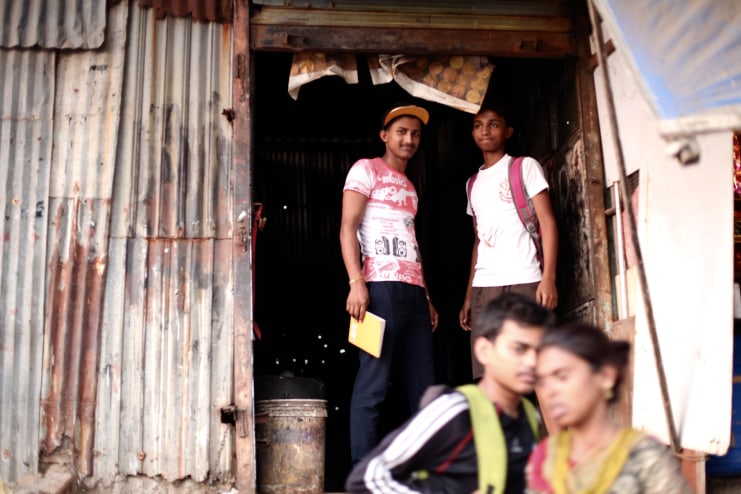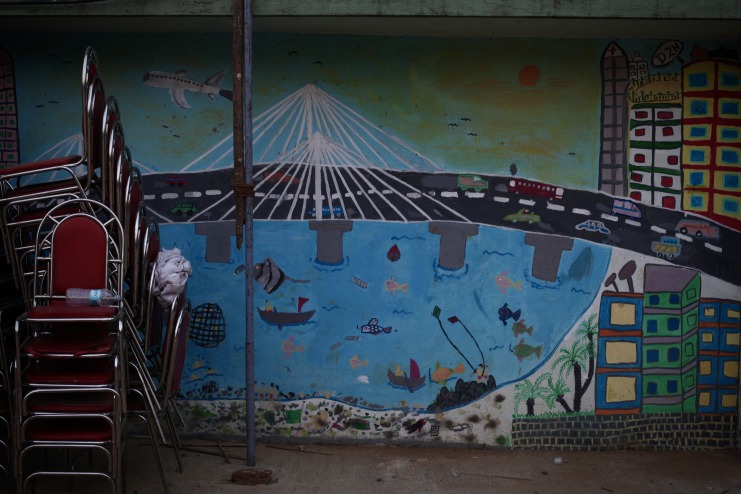Dharavi Diary Students create art installations for Earth Day using recycled materials. (Image courtesy of Dharavi Diary)
Dipali, a young girl half my size, fetched me from a busy intersection in Dharavi, a locality in Mumbai with one of the largest slums in the world. While she led me to her after school program, we talked about her classes, how many languages she knows (4), and her extra-curriculum studies in coding. She talked excitedly about HTML programming, but I could not understand what she was saying -- not because of her English, which was perfect, but because I am a terrible Millennial and do not know back ends from front ends of digital devices.
At the top of a steep narrow staircase that descends into one of the slum’s neighborhoods, we slipped into a small room filled with perhaps two dozen students sitting side by side, calmly flipping through workbooks, chatting on the couch and tapping away on computers. As an after-school educator, I have rarely seen such diligent and relaxed demeanors.
This is basecamp of Dharavi Diary: A Slum & Rural Innovation Project founded by Nawneet Ranjan in 2014, it focuses primarily on empowering young girls in the neighborhood through technological literacy. The girls learn computer skills and quickly began to code and develop applications geared towards female issues like violence and housework within the community.

Student-designed smartphone application to help protect women in the slums and around Mumbai from male violence. (Image courtesy of Dharavi Diary)
“We started with 14 girls, and it quickly grew to 140. Boys started coming, and we couldn’t turn them away. We were in the basement of this building then,” Ranjan told me.
“Moving on up,” I quip.
“Yes exactly, that’s part of the narrative.”
Storytelling is the fulcrum of the program. Students use visual, performing and language arts to explore subjects and interpersonal relations. Every 15 days, over 200 students in the after-school program work on their respective “Who Am I” stories, a writing project to reflect on personal strengths, weaknesses, and how to develop the narratives they want to live and tell.
The stories are not always easy to share, as the students regularly experience and witness abuse, violence and the very painful realities of living in poverty. Showing vulnerability towards such personal truths is not something many of us are able to do in a public setting, so Ranjan focuses on cultivating ownership and a safe space that belongs to the youth. “They have the keys to the building,” he tells me. It made me remember the time I trusted a student with a key to a garden shed. The story ends with me purchasing bolt cutters…
“Stories make learning more fun," Ranjan explains. "The bridge [in learning] becomes more organic. When we share our stories, we understand we are part of a larger family tree.”
Ranjan comes from a storytelling background, including touring India as a teenager performing community theater to draw attention to the injustices of the Bhopal gas leak, and also documentary work in both India and San Francisco. He invites youth to use narrative platforms to explore what is important to them.

Two Dharavi Diary student give a presentation about gender. (Image courtesy of Dharavi Diary)
The students recently finished hosting more than 50 community screenings of “Period of Change,” a film they collectively made about menstruation, still an extremely taboo subject throughout India. By making this documentary together, not only did the female students have an opportunity to express their hardships, but the male students could better comprehend their peers’ experiences and help assess solutions for change.
“Through regular dialogue, the really complex issues we face often become quite simple,” Ranjan believes.
Since the start of the program, Ranjan has noticed change in how the female youth are treated in their community: “They are starting to participate in decisions and see larger pictures. Domestic violence is going down and so is the rate of young marriages.” He adds that overall, both female and male students are improving in scholastic performance, most moving into the 70th or 80th percentile of their classes.
“We are not learning how to memorize and vomit information," he says. "We are learning about the process and how to celebrate it. When you understand the process, you care more.”
I met with Ranjan and his students to help provide some resources and ideas for expanding their gardening projects. They had already planted dozens of fruit-bearing and medicinal trees around the field where they play football, but wanted to explore more vegetable production. For an organization so focused on technological literacy, I was surprised by the interest in gardening. “Nothing is in isolation,” Ranjan tells me. “Gardening can help shift the consciousness of the urban notion. It also gives students grit.”
I could not agree more. A garden offers a space for exploring so many different subjects, emotions, skills, and especially life cycles. It is a space wrapped intricately in life and death, depicting the beauty and necessity of both.

In front of their new space where Dharavi Diary students plan to build an indoor garden and host salad bar pilot project. (Image credit Lauren Ladov)
Ranjan and a couple of the male students lead me upstairs to their recently acquired street-facing space (moving on up again). Lifting the heavy shutter door revealed a dark interior with high corrugated metal walls which would surely radiate the summer heat more intensively. Immediately, I envisioned vining trellises of beans climbing skyward, suspended bamboo troughs holding strawberries, buckets of hot peppers, tomatoes, and assorted herbs lining every inch of floor. The grey gloom could soon meet green vibrancy. The students seemed excited by the potential, especially the strawberry idea.
The Dharavi gardens will also serve as a pilot for a salad bar project, testing best practices for growing greens in small spaces so they can share the methods with unemployed mothers in the community who can earn extra cash through their harvests. Ranjan constantly encourages students to see the potential for frugal and improvisation innovation all around them. For instance, houses in the slums are often stacked on top of each other, so staircases are extremely steep. Many families hang ropes so the stairs are easier to climb. This is innovation. Or, when a panel in a fan breaks, fashioning a new panel out of cardboard is not only quick-thinking but accessible. This is innovation.
“I want to see these students grow into sustainable creators, focusing on ecological, local and longterm solutions for products. We do not need more obedient Unilever consumers. We have a different kind of Silicon Valley here,” he explains. Sitting in the room are youth from all corners of India. The Dharavi square mile is not just one of the most populated, it is one of the most ethnically diverse in India.
“Diversity is giving space to the other, having a safety net for sharing different points of view -- where you have the freedom to say “no” or to experiment. And we use our diversity for problem-solving,” Ranjan reveals.

Dharavi Diary student-made mural on local college wall depicting their view of Mumbai. (Image credit Lauren Ladov)
I inquire about the problem of sea-level rise for this coastal community of over 1 million, whose homes are generally constructed with makeshift materials.
“Climate change is a luxurious conversation to have when every day you are struggling to survive,” he says.
I nod, hearing echoes of this particular sentiment from similar communities who do not live in the Unilever-realities where we wring our hands over which type of laundry detergent to buy.
The students file out of the center to play football across the street. I leave too, knowing that these young people are the ones equipped with the skills, moral fiber, emotional depth and imagination to solve any problem confronting their community. We just have to give them the space to be free.